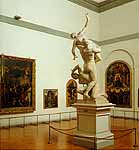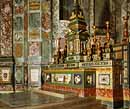
Interior of Gallery
The museum is situated in Via Ricasoli, no.60, just past the Academy
of Fine Arts.
Pietro Leopoldo, one of the most illuminated of the Lorraine Grand Dukes, commissioned
this museum in 1784 by decreeing that all the schools of drawing in Florence
were to be united into a single Academy (keeping to the same name and Statute
conceived by Vasari in 1561) and that it was to
contain a gallery of paintings by old masters to help the studies of the young
artists. It is still here in the buildings that once belonged to the Hospital
of San Matteo and to the nearby convent of San Niccoló. The Grand Duke
also decided to include music (the Cherubini Conservatory of today) and restoration
(the Opificio delle Pietre Dure) among the arts. This was a real citadel of the
arts which occupied, and still occupies, almost the entire block between Piazza
San Marco, via Ricasoli, via degli Alfani, piazza
Santissima Annunziata e via Battisti.
The buildings assumed their present appearance in 1935, when the open loggia
onto St. Mark's Square, was discovered (ascribed to eitherBrunelleschi or Michelozzo , but really a work by an anonymous architect
of the end of the XIV century).
Both the Academy Gallery and the future classrooms were designed and restructured
in 1781 by Gaspare Maria Paoletti.
The first room contains the original plaster model by Giambologna for
the marble sculptures of the Rape of the Sabines (Loggia
dei Lanzi) and 16th century works from the Mannerist school.

David by
Michelangelo
These are followed by the Captives (originally for the tomb of Julius
II) who act as a guard of honour to Michelangelo 's
David (1502-4), in the beautifully lit Tribune - designed specifically by architect
De Fabris- situated at the far end of this spectacular gallery.
Substituted by a copy in Piazza della Signoria in 1873,
the sculpture represents a heroic and athletic figure, the symbol of the freedom
of the Florentine Republic.
On the right of the famous statue one can see a bronze bust of Michelangelo by
his pupil and friend Daniele da Volterra, known as "Braghettone"
(a person wearing wide breeches) because he was later ordered to
cover Michelangelo's nude figures in the Last Judgment with drapery.
Flemish tapestries portraying the Story of the Genesis, from cartoons by Van
Orley (1552), hang on the walls behind the Captives and St. Matthew by Michelangelo (1505).
The so-called Palestrina Pietà, which some critics believe is not by Michelangelo
but by his workshop, is placed further forward to the right.
This is followed by a series of rooms which contain the famous Adimari Cassone,
showing an elegant wedding procession in Piazza Duomo, probably
carried out by Masaccio's brother, Giovanni di
Ser Giovanni (1420), a Madonna and Child, attributed to Botticelli, and works
by Florentine artists and Perugino.
A large collection of plaster casts by 19th century Tuscan artists is contained
in the room on the left.
Near the exit one can find several rooms containing 13th and 14th century works
of art, including many paintings by pupils of Giotto: Mary Magdalen by Giotto,
the Pietà by Giovanni da Milano (1365), Stories of St. Francis and Christ
by Taddeo Gaddi. The last room exhibits a fine collection of Byzantine and Florentine
painters of the same period.

Altar of the
Chapel of the Princes
If one continues along Via Ricasoli in the direction of the Duomo, one comes to Piazza delle Belle Arti, where the Museum
of Musical Instruments of the Luigi Cherubini Conservatory is situated
(at present closed for restoration).
The Museum of Semi-precious Stones and Mosaics is further on, at no.78, together
with the Opificio, which was originally set up by Ferdinando
I dei Medici (1588) to create the magnificent decorations for the Chapel
of the Princes in San Lorenzo, a real family Pantheon. This institution is quite
unique in the world and provides materials and highly specialized labour for
original works and restoration in all parts of the globe. The museum contains
furniture, paintings, statues, cameos, caskets and various kinds of inlaid work
carried out in marble and semi-precious stones from all over the world.
